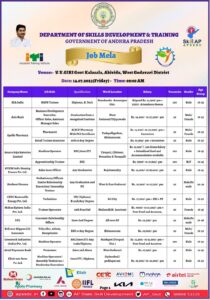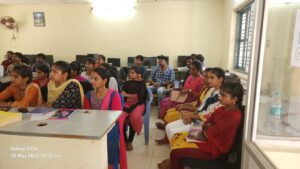Proceeding Of Skill Hub
Proceeding Of Skill Hub >>>>> View
MOU with Skill Hub
Memorandum Of Understanding (MOU) >>>>> View
Sewing Machine Operator (Course-1)
Sewing Machine Operator
At the end of the program, the learner should have acquired the listed knowledge and skills.
Prepare for stitching operations.
- Stitch components to produce apparels.
- Contribute to achieve product quality in stitching operations.
- Maintain the work area, tools and machines.
- Maintain health, safety and security at the workplace.
- Comply with the industry, regulatory and organizational requirements.
| Module Details |
| Module 1 : Introduction and Orientation- Bridge Module and Soft Skills |
| Module 2 : Maintain workarea, tools and machines |
| Module 3 : Maintain health, safety and security at work place with Gender and PwD Sensitization |
| Module 4 : Comply with industry, regulatory and organizational requirements and Greening of Job roles |
| Module 5 : Preparation for stitching operations |
| Module 6 : Stitch components to produce apparels |
| Module 7 : Contribute to achieve product quality in stitching operations |
| Module 8 : Employability Skills |
Assistant Electrician (Course-2)
Assistant Electrician
After completing this programm, participants will be able to:
• Select and use hand, power tools and electrical devices relevant to construction electrical works: – Recognizing, differentiating and using electrical tools and devices appropriately in basic electrical operations
• Install temporary lighting arrangement at construction sites: – Selection and use of light units, accessories, fixtures and tools for installing and maintaining lighting arrangements used for construction work
• Install LV electrical wiring at permanent structures: – Identification, selection and handling of electrical fixtures, tools and materials and use them in house wiring activity. Basic electrical tests which are performed to inspect wiring
• Assemble, install and maintain temporary LV electrical panels (distribution boards) at construction site: – Selection and use of electrical fixtures, components and tools to assemble and maintain temporary electrical panels required for construction works
• Work effectively in a team to deliver desired results at the workplace: – Organized working procedure within a team at site
• Plan and organize work to meet expected outcomes: – Prioritizing activities and organising resources to meet desired outcome
• Work according to personal health, safety and environment protocol at construction site: – Importance of Health & Safety aspects & measures to be followed while working
Compulsory Modules
Module 1 : Introduction to thejob role – (Lecture/description by concerned trainer)
Module 2 : Select and use hand, power tools and electrical devices relevant to construction electrical works
Module 3 : Install temporary lighting arrangement at construction sites
Module 4 : Install LV electrical wiring at permanent structures
Module 5 : Assemble, install and maintain temporary LV electrical panels (distribution boards) at construction site
Module 6 : Work effectively in a team to deliver desired results at the workplace
Module 7 : Plan and organize work to meet expected outcomes
Module 8 : Work according to personal health, safety and environment protocol at construction site
Trainee Beautician (Course-3)
Trainee Beautician
Course Outcomes (COs):
After successful completion of the course, students will be able to:
1. Work As Fashion Show Stylist, Cosmetology instructor & Beauty Magazine Writer.
2. Start her Own Franchise Independently or in Collaboration With Lakme, L’Oreal, VLCC.
3. Work As Make-up Artist in the fashion Industry & Film Industry.
4. Work As Professional Trainer For The New Learners.
5. Do Ayurvedic Cosmetology and Sale Natural Hurbs & Plants Which Can Be Incorporated into
Skin & Hair Care.
Learning Objectives (LOs):
1. To provide basic knowledge of the Natural Hurbs & Plants and Cosmetics.
2. To understand the various Make-up Pattern.
3. To learn organizing Fashion Show Program and beauty trend programs .
4. To identify the Skin types & Hair types for special treatment.
Unit I : Introduction
1.1 Threading one eyebrow with different shapes (kinds of shapes)
1.2 Hair Style advanced with Decoration
1.3 Bleach All Types
1.4 Mehendi Arabian & bridal Sparkle
1.5 Rangoli Advanced stager
1.6 Facial Advanced with Training & Rubber pack
1.7 Wax two type chocolate & diamond
1.8 Skin treatment herbal treatment
Unit II : Skin Treatment
2.1 Manicure with Hot Spa
2.2 Pedicure with cold spa
2.3 Hair cutting & make up Advance
Unit III : Hair cutting and make up
3.1 Study on hair
3.2 Make up advanced specialty pan
3.3 Sari wearing 20 types
Unit IV : Skin and hair Treatment
4.1 Study on skin
4.2 Treatment hair problems
4.3 Dandruff Study
4.4 Head massage
4.5 Pimple removing study
4.6 Practices on treatment
4.7 Hair coloring
4.8 Bridal
Software Programmer (python)
Software Programmer (Python)
Training Outcomes
At the end of the program, the learner should have acquired the listed knowledge and skills. Compulsory:
- Design algorithms to solve problems and execute test cases to convert them into code.
- Understand software development lifecycle and software design specifications.
- Demonstrate interpersonal skills, digital and financial skills, and work ethic.
Elective-2: Python Programming
- Understand the basics of Python programming
- Explain the concepts of data structures in Python and use databases in Python programming
- Develop software code using core Python programming
- Execute, test, and debug the Python program
Module Details
Module 1: Programming and Algorithms
Module 2: Analysis and Design of Software Applications
Module 3: Introduction to Employability Skills
Module 4: Constitutional values – Citizenship
Module 5: Becoming a Professional in the 21st Century
Module 6: Basic English Skills
Module 7: Career Development and Goal Setting
Module 8: Communication skills
Module 9: Diversity and Inclusion
Module 10: Financial and Digital Literacy
Module 11: Essential Digital Skills
Module 12: Entrepreneurship
Module 13: Customer Service
Module 14: Getting Ready for Apprenticeship and Jobs
Theory – Key Learning Outcomes
- Understand the basics of Python programming
- Outline the evolution of programming languages
- Distinguish between imperative and declarative programming paradigms
- List the features of object-oriented programming: Class, Object, Encapsulation, Abstraction, etc.
- Describe the features of Python as programming language
- Outline the terminology used in Python programming such as interpreter, lambda, loader, method, etc.
- Explain how Python can act as both compiled and interpreted language
- List the tools used for programming in Python such as IDLE, Jupiter etc.
- Explain various core datatypes (numbers, strings, dictionaries, etc.) variables, operators (arithmetic, relational, logical, bitwise, etc.), strings and arrays in the context of python programming
- Discuss the concepts of memory allocation
- Explain the concepts of relational database management system
- Describe the concepts, types and operations related to core Python elements such as numeric types, dynamic typing interlude, lists, dictionaries, tuples, etc.
- Explain the syntax rules, assignments, iteration, and comprehensions
- Discuss various control flow statements (if, then, while, for, nested if, etc.) in Python programming
- Explain the concepts and various types of methods/ functions, scopes, modules and class
- Explain OOP features and more advanced elements of Python such as advanced modules, class coding, operator overloading, multiple inheritance, lambda, decorators, meta classes, gotchas, managed attributes, data streams, metadata, design patterns etc.
- Describe various frameworks/ methods used in testing a Python program
- Explain the steps involved in debugging a Python program
- Explain various exceptions and exception handling methods
- Discuss coding standards and best practices related to Python
Practical – Key Learning Outcomes
- Demonstrate the elements of imperative programming such as variables, flow control and functions
- Familiarize with the platforms used for Python programming (e.g., IDLE and Jupiter)
- Demonstrate the use of type conversions
- Use arrays, strings, and operators to declare variables
- Demonstrate the use of RDBMS in Python programming
- Demonstrate the use of control flow statements as part of Python code
- Create expressions and statements to implement, core Python elements
- Write sample codes to explore the OOP features and advanced elements of Python programming
- Create the following: 1. python library 2. data streams access modes 3. basic python app packaging
- Create suitable test cases to identify bugs in a Python program
- Demonstrate how to debug a Python program
- Demonstrate the ways to execute a Python app and deploy it
- Implement exception handling methods in Python
- Demonstrate python app deployment using Git and GitHub
Associate Data Entry Operator (Course-5)
Associate Data Entry Operator
Training Outcomes
At the end of the program, the learner should have acquired the listed knowledge and skills.
-
Explain data entry services and the policies applicable.
-
Inspect the data being entered from multiple sources to check authenticity and remove errors.
-
Categorize and examine the essential steps required to verify, analyse data.
-
Examine common errors and plan to mitigate the same.
-
Estimate a suitable timeline for completing a data entry process.
-
Illustrate proper ways of upskilling data entry process through use of advanced software.
-
Demonstrate application of various IT components including browsers and various operating systems.
-
Illustrate proper ways of maintaining confidentiality of storing security and back up files for future use.
-
Demonstrate application of various solutions for different types of incidents/service requests.
-
Demonstrate effective work planning principles using time and resources effectively.
-
Describe how to maintain a healthy, safe, and secure environment at workplace.
Module Details
Module 1: Concept of Data Entry
Module 2: Software Requirement for Data Entry
Module 3: Process of Data Entry
Module 4: Troubleshooting in Data Entry Process
Module 5: Assisting Data Entry Process
Module 6: Skillsets of Data Entry Services
Module 7: Incident Management in Data Entry Services
Module 8: Introduction to Employability Skills
Module 9: Constitutional values – Citizenship
Module 10: Becoming a Professional in the 21st Century
Module 11: Basic English Skills
Module 12: Career Development and Goal Setting
Module 13: Communication skills
Module 14: Diversity and Inclusion
Module 15: Financial and Digital Literacy
Module 16: Essential Digital Skills
Module 17: Entrepreneurship
Module 18: Customer Service
Module 19: Getting Ready for Apprenticeship and Jobs
Domestic Data Entry Operator (Course-6)
Domestic Data Entry Operator
Training Outcomes
After completing this programme, participants will be able to:
-
Undertake data entry services
-
Manage their work to meet requirements
-
Maintain a healthy, safe and secure working environment
Module Details
Module 1 : Data Entry Services
Module 1 : Self and Work Management
Module 1 : Managing Health and Safety
Key Learning Outcomes
-
Obtain information from customer/client to be entered.
-
Adhere to organizational processes and policies to record and perform the service request.
-
Revert to the customer on a reasonable estimate time of delivering the desired outcome.
-
Prioritize service requests according to organizational guidelines.
-
Transcribe, enter, and verify data from multiple sources.
-
Verify accuracy of transcribed data with the source document and correct any errors.
-
Escalate, seek advice from specialists if the problem is beyond competence or experience factor.
-
Make appropriate corrections for any error messages that arise, while entering data.
-
Organize source documents and filing relative to data entered.
-
Ensure security storage and back up of data files.
-
Share progress or any delays in the process with customers.
-
Comprehend your work requirements, output, target with appropriate people as per organization policy.
-
Use your time and resources judiciously.
-
Keep the workplace clean and operate in a tidy environment.
-
Treat confidential information correctly.
-
Comply/adhere with your organization’s current health, safety and security policies and procedures.
-
Be aware about correct emergency procedures.
-
Report to supervisor or authorized personnel, if any hazard is identified
Solar Panel Installation (Course-7 )
Solar Panel Installation
Training Outcomes
At the end of the program, the learner should have acquired the listed knowledge and skills:
-
Describe the process of checking site conditions, collect tools and raw materials.
-
Demonstrate the process of installing the solar panel.
-
Explain the importance of following inclusive practices for all genders and PwD at work.
-
Demonstrate various practices to be followed to maintain health and safety at work.
Module Details
Module 1: Introduction and orientation to the role of a Solar Panel Installation Technician
Module 2: Process of checking site conditions, collect tools and raw materials
Module 3: Process of installing the solar panel
Module 4: Soft Skills and Work Ethics
Module 5: Basic Health and Safety Practice
Module 6: On-the-Job Training
Theory – Key Learning Outcomes
-
Describe the size and scope of the electronics industry and its subsectors.
-
Discuss the role and responsibilities of a Solar Panel Installation Technician.
-
Describe various employment opportunities for a Solar Panel Installation Technician.
-
Explain company’s policies on incentives, personnel management, code of conduct, documentation, installation, customer support etc.
-
Describe company’s different department and concerned authority, culture and reporting structure.
-
Explain the importance of individuals role in the work flow.
-
Explain the basics of solar energy and power generation systems.
-
Describe the use and handling procedure of solar panels.
-
Explain basic electrical system and its functioning.
-
Explain mechanical equipment and its functioning.
-
Describe maintenance procedure of equipment.
-
State various parameters for assessing the site suitability for solar panel installation.
-
List the tools involved in installation of system.
-
State various quality and process standards.
-
Explain the importance of wearing protective clothing and other safety gear while carrying out installation.
-
Explain company’s policies on: incentives, personnel management.
-
Explain company’s code of conduct.
-
Explain the importance of individuals role in the work flow.
-
Explain company’s installation and customer support policy.
-
Explain the basics of solar energy system and power generation.
-
Describe various solar energy system components such as panels, batteries, charge controllers, inverters.
-
Explain the significance of volts, amps and watts: series and parallel connection. • Explain the handling procedure for solar panels.
-
Explain basic electrical system and its functioning.
-
Explain mechanical equipment and their functioning.
-
Describe the maintenance procedure of equipment.
-
State the voltage requirement of various equipment.
-
State panel mounting and inclination and angle of tilt.
-
Explain the importance of sunlight and direction assessment.
-
Describe site surveying methods and evaluation parameters.
-
List various tools involved in installation of system.
-
Explain basic electrical engineering and circuitry.
-
State occupational health and safety standards and waste management procedures.
-
State the importance of work ethics and workplace etiquette
-
State the importance of effective communication and interpersonal skills.
-
Explain ways to maintain discipline at the workplace.
-
Discuss the common reasons for interpersonal conflict and ways of managing them effectively.
-
Discuss the importance of following organisational guidelines for dress code, time schedules, language usage and other behavioural aspects.
-
Explain the importance of working as per the workflow of the organisation to receive instructions and report problems.
-
Explain the importance of conveying information/instructions as per defined protocols to the authorised persons/team members.
-
Explain the common workplace guidelines and legal requirements on non-disclosure and confidentiality of business-sensitive information.
-
Describe the process of reporting grievances and unethical conduct such as data breaches, sexual harassment at the workplace, etc.
-
Explain the concept and importance of gender sensitivity and equality.
-
Discuss ways to create sensitivity for different genders and Persons with Disabilities (PwD).
-
Develop a sample plan to achieve organisational goals and targets.
-
Create a sample feedback form to obtain feedback from customers, colleagues etc.
-
Roleplay to demonstrate the use of professional language and behaviour that is respectful of PwD and all genders.
-
Apply organisational protocol on data confidentiality and sharing only with the authorised personnel. 12 | Solar Panel Installation Technician
-
Discuss ways of dealing with heightened emotions of self and others.
-
Discuss job-site hazards, risks and accidents.
-
Explain the organizational safety procedures for maintaining electrical safety, handling tools and hazardous materials.
-
Elaborate on electronic waste disposal procedures.
-
Describe the process of disposal of hazardous waste
-
List the name and location of concerned people, documents and equipment for maintaining health and safety in the workplace.
-
Describe how to interpret warning signs while accessing sensitive work areas.
-
Explain the importance of good housekeeping.
-
Describe the importance of maintaining appropriate postures while lifting heavy objects.
-
List the types of fire and fire extinguishers.
-
Explain the importance of efficient utilisation of water, electricity and other resources.
-
List the common sources of pollution and ways to minimize it.
-
Describe the concept of waste management and methods of disposing hazardous waste.
-
Explain various warning and safety signs.
-
Describe different ways of preventing accidents at the workplace.
Terminal Outcomes
- Explain the use and handling procedure of solar panels.
- Assess the degree of inclination and angle of tilt of PV module for the specific area, locality or region to enable the system absorb maximum annual sunlight.
- set the mounting fixture firmly at the desired location.
- Install spare fuse to avoid any short circuits as per company policy.
- Connect multiple PV modules in combination to generate the desired voltage and current.
- Connect the system and check its functioning.
- Dispose-off any waste materials in accordance with safe working practices and procedures.
- Develop a sample plan to achieve organisational goals and targets.
- Demonstrate the use of professional language and behaviour that is respectful of PwD and all genders.
- Use the protective equipment suitable as per tasks and work conditions.
- Administer first aid in case of a minor accident.
- Use a fire extinguisher in case of a fire incident.
Job Mela



Job Mela >>>>
Results
Certificates
Certificates Of Sewing Machine Operator >>>>> View
Certificates Of Assistant Electrician >>>>> View
Certificates Of Trainee Beautician >>>>> View
Certificates Of Software programmer [BATCH-I] >>>>> View
Certificates Of Software programmer [BATCH-II] >>>>> View
Certificates Of Associate Data Entry Operator [BATCH-I] >>>>> View
Certificates Of Associate Data Entry Operator [BATCH-II] >>>>> View
Certificates Of Associate Data Entry Operator [BATCH-III] >>>>> View
Gallery
Facilities of Skill Hub:-


Skill Hub Class Room:1 Skill Hub Class Room:2



Hot&Cool Water Dispenser 55″ Large Screen L.E.D T.V for Digital Learning System Inverter & Battery
High Speed Internet 360* Rotating Chairs
Teaching System:-
Python Classes





